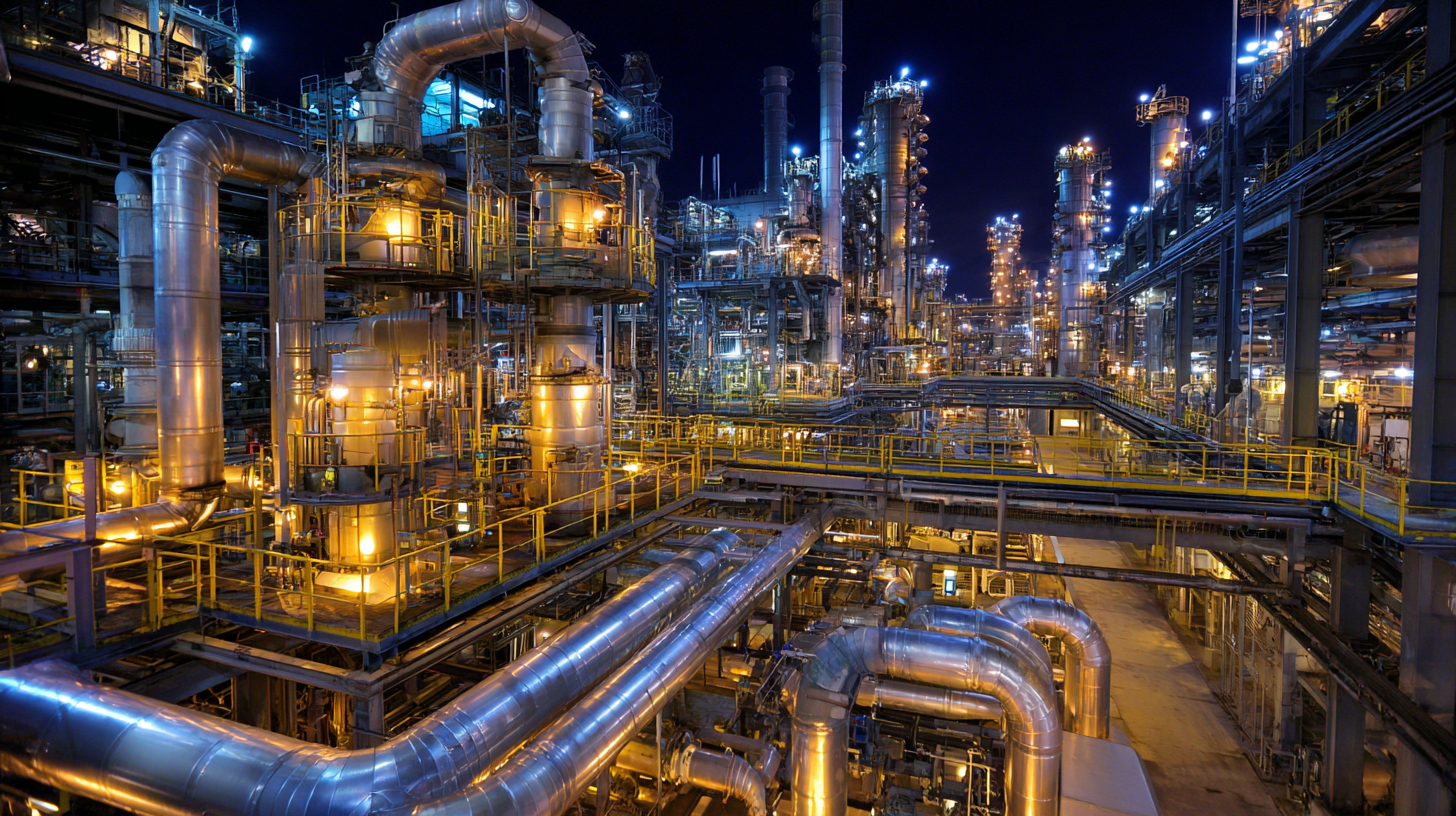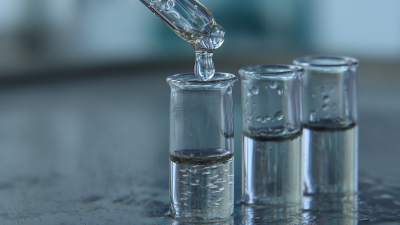How to Effectively Utilize A-(2-Propylheptyl)-Ω-Hydroxy- in Industrial Applications
Table of Contents
- Understanding the Unique Properties of A-(2-Propylheptyl)-Ω-Hydroxy- for Industrial Uses
- Key Industrial Sectors Benefiting from A-(2-Propylheptyl)-Ω-Hydroxy- Applications
- Top Five Best Practices for Implementing A-(2-Propylheptyl)-Ω-Hydroxy- in Manufacturing
- Maximizing Efficiency: A-(2-Propylheptyl)-Ω-Hydroxy- in Product Formulation and Development
- Common Challenges in Utilizing A-(2-Propylheptyl)-Ω-Hydroxy- and How to Overcome Them
- FAQS
- Conclusion
- Related Posts
In recent years, the demand for high-performance specialty chemicals has surged across various industries, driven by advancements in technology and increasing consumer expectations. One such compound, Α-(2-Propylheptyl)-Ω-Hydroxy-, has garnered attention for its versatile applications, particularly in the formulation of surfactants, additives, and intermediates. According to market research, the global specialty chemicals market is projected to reach USD 1 trillion by 2025, highlighting the critical role that innovative compounds play in sectors such as personal care, oil and gas, and agrochemicals. At SHANGHAI QIXUAN CHEMTECH CO., LTD., we are dedicated to producing specialty chemicals, including fatty amines and amine derivatives, cationic and nonionic surfactants, and Polyurethane catalysts. This guide aims to explore the effective utilization of Α-(2-Propylheptyl)-Ω-Hydroxy- in industrial applications, providing valuable insights for manufacturers looking to enhance their product offerings and meet the evolving market demands.

Understanding the Unique Properties of A-(2-Propylheptyl)-Ω-Hydroxy- for Industrial Uses
A-(2-Propylheptyl)-Ω-Hydroxy- has emerged as a noteworthy substance for various industrial applications due to its unique properties. This compound offers exceptional stability and compatibility with other materials, making it ideal for formulations in sectors such as pharmaceuticals and personal care. Its hydroxy- group enhances its solubility in organic solvents, facilitating its incorporation into diverse products ranging from cosmetics to industrial lubricants.
The global market dynamics also indicate an increased interest in high-performance chemicals like A-(2-Propylheptyl)-Ω-Hydroxy-. For instance, the expandability of the electronics sector, driven by advancements such as 5G technology, has created significant demand for innovative materials. In parallel, the global bentonite market is projected to reach $6.99 billion in 2024 and grow steadily to $9.45 billion by 2032, with a compound annual growth rate (CAGR) of 4.0%. Such trends underscore the necessity for versatile and efficient chemical compounds, enabling industries to meet their evolving needs.
Key Industrial Sectors Benefiting from A-(2-Propylheptyl)-Ω-Hydroxy- Applications
 A-(2-Propylheptyl)-Ω-Hydroxy- has emerged as a significant compound in various industrial sectors, due to its unique properties and versatility. One of the primary industries benefiting from its applications is the automotive sector. The compound is utilized in the formulation of lubricants and additives that enhance engine performance and improve fuel efficiency. This is especially critical as manufacturers strive to meet stringent environmental regulations while also enhancing the longevity of vehicle components.
A-(2-Propylheptyl)-Ω-Hydroxy- has emerged as a significant compound in various industrial sectors, due to its unique properties and versatility. One of the primary industries benefiting from its applications is the automotive sector. The compound is utilized in the formulation of lubricants and additives that enhance engine performance and improve fuel efficiency. This is especially critical as manufacturers strive to meet stringent environmental regulations while also enhancing the longevity of vehicle components.
Another key sector that sees substantial advantages from A-(2-Propylheptyl)-Ω-Hydroxy- is the manufacturing of personal care products. Its excellent emollient properties make it an ideal ingredient in creams, lotions, and cosmetics, where it serves to improve skin absorption and provide a smooth application. Additionally, the compound's stability under various conditions ensures that personal care formulations maintain their effectiveness and appeal over time.
The agricultural industry also incorporates A-(2-Propylheptyl)-Ω-Hydroxy- in the formulation of pesticides and herbicides. Its ability to enhance the solubility and distribution of active ingredients ensures that agricultural products perform efficiently, leading to better crop yields while minimizing environmental impact. This multifunctionality positions A-(2-Propylheptyl)-Ω-Hydroxy- as a valuable asset across these diverse industrial applications.
Top Five Best Practices for Implementing A-(2-Propylheptyl)-Ω-Hydroxy- in Manufacturing
When integrating A-(2-Propylheptyl)-Ω-Hydroxy- into industrial applications, manufacturers should adopt best practices to enhance efficiency and product quality.
 The first practice involves thorough material assessment. Understanding the chemical properties and compatibility of A-(2-Propylheptyl)-Ω-Hydroxy- with other materials is crucial for preventing unwanted reactions and ensuring optimal performance in various processes.
The first practice involves thorough material assessment. Understanding the chemical properties and compatibility of A-(2-Propylheptyl)-Ω-Hydroxy- with other materials is crucial for preventing unwanted reactions and ensuring optimal performance in various processes.
Secondly, training and educating staff on the safe handling and application of this chemical compound is essential. Workers should be well-informed about the specific features of A-(2-Propylheptyl)-Ω-Hydroxy- and potential hazards associated with its use. Implementing regular training sessions fosters a culture of safety and promotes best practices in the workplace.
Lastly, continuous monitoring and evaluation of processes involving A-(2-Propylheptyl)-Ω-Hydroxy- can lead to significant improvements. By collecting data on performance metrics, manufacturers can identify areas for improvement and innovation, ensuring that their application of this compound remains effective and aligned with industry standards. These practices not only enhance productivity but also contribute to sustainability efforts in manufacturing.
Maximizing Efficiency: A-(2-Propylheptyl)-Ω-Hydroxy- in Product Formulation and Development
In the realm of industrial applications, the incorporation of A-(2-Propylheptyl)-Ω-Hydroxy- into product formulation and development is gaining traction due to its unique properties that enhance efficiency. This compound acts as a multifunctional additive, providing not only excellent stabilizing capabilities but also aiding in the overall performance of formulations. By optimizing the use of A-(2-Propylheptyl)-Ω-Hydroxy-, manufacturers can achieve a more consistent product quality while addressing specific performance criteria required by their end-users.
Moreover, implementing this compound allows for improved compatibility with various other ingredients, ensuring a seamless integration into existing formulations. This compatibility helps to reduce formulation times and costs, ultimately leading to a more efficient production process. Additionally, the use of A-(2-Propylheptyl)-Ω-Hydroxy- can contribute to increased product longevity and stability, making it a valuable asset in industries ranging from cosmetics to coatings and lubricants. As industries continue to seek innovative solutions for their product lines, the strategic use of this compound will likely become an integral part of formulation and development practices.
Common Challenges in Utilizing A-(2-Propylheptyl)-Ω-Hydroxy- and How to Overcome Them
When considering the integration of A-(2-Propylheptyl)-Ω-Hydroxy- in industrial applications, a range of common challenges can arise. One major issue is the chemical's stability during processing, which can lead to inconsistent product quality. Manufacturers must ensure stringent control of environmental factors such as temperature and humidity to maintain stability. Additionally, difficult handling or mixing properties of the compound can hinder its effectiveness in formulations, particularly in creating uniform blends.
Another challenge involves the regulatory landscape surrounding the use of A-(2-Propylheptyl)-Ω-Hydroxy-. Compliance with industry standards is essential, and companies must stay updated on changing regulations to avoid potential legal and financial repercussions. To mitigate these challenges, engaging in thorough research and development can pave the way for innovative solutions, such as optimizing process conditions and employing advanced formulations that enhance the compound’s performance. By addressing these hurdles head-on, industries can unlock the full potential of A-(2-Propylheptyl)-Ω-Hydroxy- for their applications.
FAQS
-(2-Propylheptyl)-Ω-Hydroxy- used for in the automotive sector?
This compound serves as an excellent emollient in creams, lotions, and cosmetics, improving skin absorption and application while maintaining stability under various conditions to ensure formulation effectiveness.
A-(2-Propylheptyl)-Ω-Hydroxy- enhances the solubility and distribution of active ingredients in pesticides and herbicides, leading to better crop yields and reduced environmental impact.
Thorough material assessment is crucial to understand its chemical properties and compatibility with other materials to prevent unwanted reactions and ensure optimal performance.
Training ensures that workers are informed about the safe handling and application of the compound, fostering a culture of safety and promoting best practices in the workplace.
By collecting performance metrics data, manufacturers can identify areas for improvement and innovation, ensuring the compound's application remains effective and aligned with industry standards.
Conclusion
In the realm of specialty chemicals, Α-(2-Propylheptyl)-Ω-Hydroxy- stands out for its unique properties that foster innovation across various industrial sectors. Understanding these properties is crucial for industries such as agrochemicals, personal care, and cleaning products, where its application can enhance product efficiency and formulation. By implementing best practices in manufacturing and product development, companies can leverage Α-(2-Propylheptyl)-Ω-Hydroxy- to maximize performance while effectively addressing common challenges associated with its use.
At SHANGHAI QIXUAN CHEMTECH CO., LTD., we specialize in producing a diverse range of specialty additives, including Α-(2-Propylheptyl)-Ω-Hydroxy-. This enables us to provide tailored solutions that meet the specific needs of our clients across multiple sectors, ensuring that they can achieve optimal results in their industrial applications.
Related Posts
-

Exploring Unique Alternatives for Oleyl Diamine Polyxyethylene Ether
-

Innovative Applications of Best Waterproof Coating in Construction and How to Achieve Long Lasting Results
-

Exploring Industry Applications of Best Cas 91995-81-2: Solving Common Challenges in Production
-

Exploring the Advantage of Best Efficient And Easy To Disperse Products in Industrial Applications
-

How to Identify Top Quality Suppliers for Best Oleyl Diamine Ethoxylate Products
-

Navigating Industry Standards for Optimal Emulsification of High Viscosity CRS
Blog Tags:

